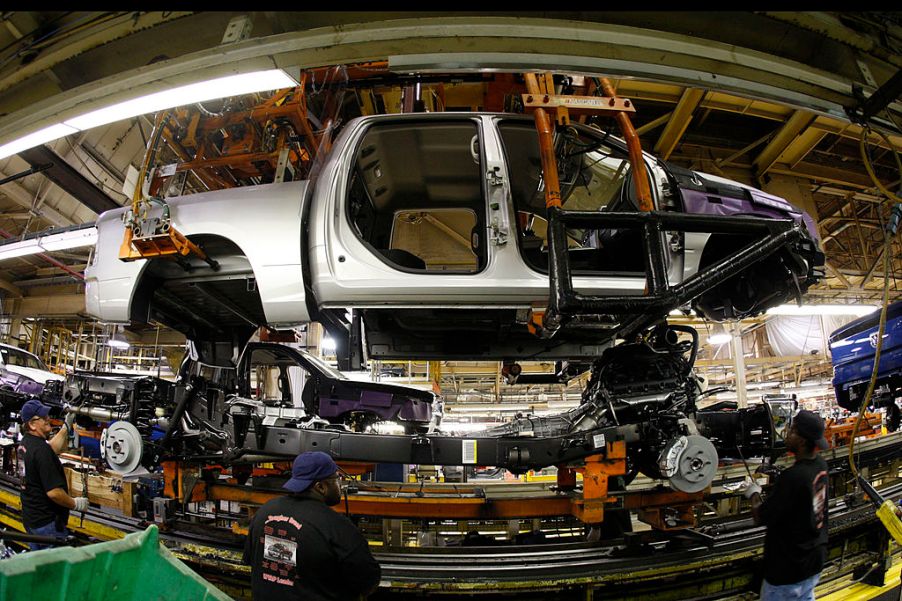
What Is a Chassis Truck and How Is It Different From a Pickup Truck?
While a chassis truck resembles a pickup truck, the two do have a number of important differences. A chassis truck, which is also called a chassis cab truck or a cab and chassis truck, is usually sold as an incomplete vehicle meant to be finished after purchase. When bought, it just has the frame rails in the back behind the cab.
A chassis cab truck is a commercial vehicle, and it’s more basic than the pickup, with fewer features available. Its capabilities are designed for function, especially transporting heavy materials. The front looks about the same as the pickup, but the rear has a reinforced platform instead of a boxed pickup bed.
Depending on the buyer’s commercial needs, various configurations can be added to the platform by a third-party up-fitter or sometimes by the original manufacturer. A dump truck body is great for transporting gravel or soil for landscaping or construction companies. The service body, or utility bed, is useful for electricians or plumbers transporting tools. The concrete/stake body is good for concrete contractors. Other options are the flatbed and the bucket truck body.
Unlike chassis cab trucks, pickup trucks come with a boxed pickup bed already installed behind the cab. These multipurpose trucks can be used for commercial or private purposes or both. Pickup trucks are smooth to drive and have good performance abilities, especially for towing.
Here’s a look at the differences between the two truck styles.
Frame rails: straight vs. curved
The frame rails are designed differently on each style of truck. Chassis cab trucks have straight frame rails that are a standard size. This makes it possible to install standard up-fit equipment on any chassis cab truck.
Frame rails on pickup trucks are curved behind the cabin. This helps improve the ride quality and weight distribution. Frame rails on pickups tend to be model and manufacturer-specific designs and not interchangeable.
Optional equipment: commercial vs. comfort
Some optional features that can be chosen for chassis cabs are not available on pickups. This could include dual alternators, snow plow prep packages, or interior options like rubber flooring. It’s generally easier to attach aftermarket equipment on a chassis cab truck. Pickup trucks, on the other hand, have more options for comfort.
Engine power
Chassis cab trucks have lower horsepower and torque ratings, even with the same engine as a pickup truck. These changes help the truck last longer and increase fuel economy potential, both important for commercial tools.
The lower power engine places less stress on the drivetrain, helping it last longer. Pickup trucks tend to have higher trailer towing capabilities due to the higher engine power.
Gross vehicle weight rating (GVWR) and payload
The chassis cab trucks have a higher GVWR and a significantly higher payload capacity than pickups. These trucks are designed to carry a lot of weight over the rear axle. It makes sense when you think about all the weight saved from putting the standard bed on the truck.
Spring rate
Chassis cab trucks have sturdier front and rear suspensions than pickups and have industrial-grade leaf springs. The spring design assumes chassis cab trucks will be carrying a heavy payload most of the time. The suspension on pickups is designed for a smoother and more comfortable ride. Therefore, its springs are much smaller and more flexible.
Gross axle weight rating (GAWR)
Chassis cab trucks have a higher GAWR. Sometimes these trucks feature extremely large rear axles, which help to carry higher payload capacities than pickup trucks.
In addition, the axles are designed to support a variety of heavy up-fit configurations. Today’s pickup trucks do have large axles but not as large as chassis cab trucks’ axles.
Fuel capacity
Chassis cab trucks are sometimes available with larger fuel tanks, holding up to 40 or 50 gallons. Pickup truck fuel tank capacities vary but are often closer to 25 to 35 gallons. It makes sense that a truck designed for work would want to fill up less often.


